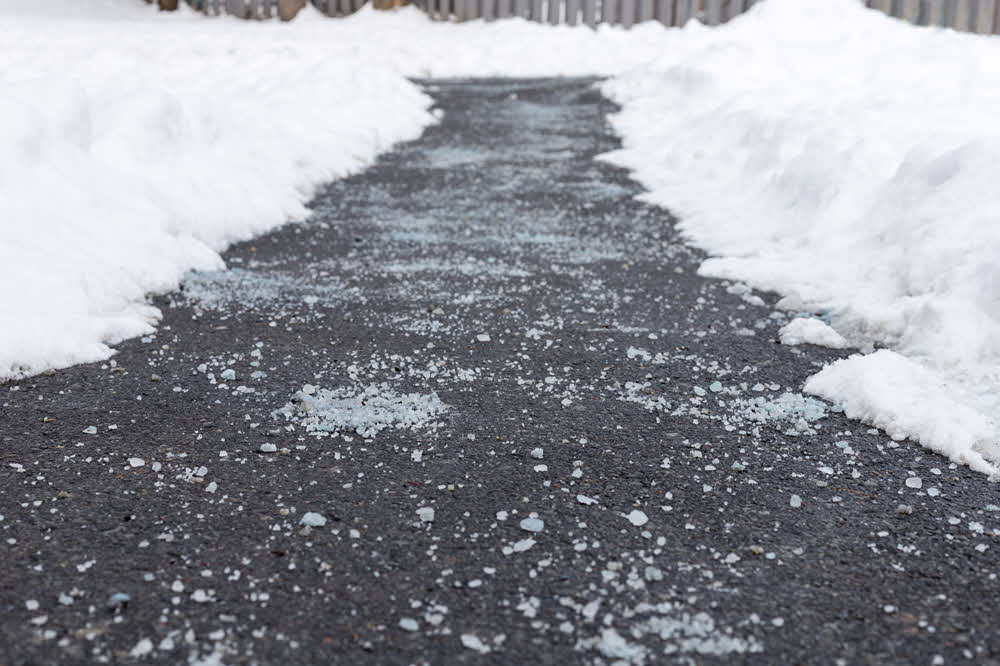Deicing Agent Applicationsin Madison Heights MI
Targeted Deicing ApplicationsTo Keep Your Property Ice-Free
We Are Locally Owned & Operated For Over 37 Years
Contact Us Today!
We Serve Businesses In And Around The Following Cities:
About Deicing Agent Applications
Understanding the Crucial Role of Deicing Agent Applications
Imagine a Madison Heights winter: the frosty air, the crisp snow, and the beautiful, idyllic scenes of ice-covered landscapes. Stunning as they may be, these winter conditions pose risks, particularly for commercial properties. Ice on roads, parking lots, footpaths, and rooftops can lead to slips, falls, and accidents, sometimes even resulting in significant liability issues for property owners. This is where the importance of Deicing Agent Applications comes into play.
The Process and Benefits of Deicing Agent Applications
Deicing Agent Applications form a vital aspect of winter property maintenance in commercial spaces. But what exactly is the process? Deicing is the procedure of removing ice or snow from a surface, typically achieved with the application of deicing agents such as salt, calcium chloride, or even more environmentally friendly options. Engaging in a regular schedule of deicing can offer numerous benefits, from improving safety and accessibility to ensuring continued business operations during the harsh winters.
Think of a business like the local grocery store in Madison Heights. As residents shuffle in to stock up on supplies, the last thing they need is slippery surfaces causing injuries. Ice melt application services take care of this, maintaining customer and employee safety, and allowing the business to function smoothly even in icy conditions.
Commercial Deicing Services
Commercial deicing services, such as those provided by D&J Contracting, offer comprehensive solutions for Madison Heights businesses. These services range from standard applications of deicing agents on ground surfaces to more specialized treatments on rooftops and even helicopter landing pads.
Just ask the property manager of a commercial complex in Madison Heights. When winter strikes, it is crucial to have safe, accessible walkways for tenants and visitors. By engaging trusted commercial deicing services like D&J Contracting, property managers can ensure that their premises remain safe and operational, whatever the weather conditions might be.
Anti-Ice Treatments
While deicing helps remove ice after it has formed, another important step in winter maintenance is anti-ice treatments. Conducted before a snowstorm hits, these treatments use specially formulated agents to prevent ice and snow from bonding to the surface. This process significantly enhances safety and can often be more cost-effective as it requires fewer resources than post-storm deicing.
Consider a storage facility in Madison Heights. An anti-ice treatment applied before a big snowfall can save hours of manual labor after the storm, ensuring that access to the facility remains unhindered and business operations continue efficiently.
Deicing Agent Distribution and Safe Deicing Solutions
The distribution of deicing agents is no less important than the application itself. Ideally, the distribution should be even, ensuring comprehensive coverage and maximum effectiveness. However, not all deicing treatments are made equal, and it’s crucial to opt for safe deicing solutions that have a minimal environmental impact.
The Madison Heights branch of a national bank, for instance, may require deicing agent distribution across its spacious car park. By choosing D&J Contracting, they’re opting for a service that’s not only effective but also respects the environment by using safe deicing solutions and optimal distribution practices.
Winter in Madison Heights, as beautiful as it may be, brings with it the challenge of icy conditions, especially for commercial properties. But with the combination of regular deicing agent applications, timely anti-ice treatments, reliable ice melt application services, and an emphasis on safe deicing solutions, these challenges can be efficiently navigated. D&J Contracting stands ready to offer such support, ensuring that your commercial property remains safe, accessible, and operational, even during the harshest of Madison Heights’ winters.
After all, inflammation is not just about icy landscapes; it’s also about the people and businesses that thrive within them, and it’s our responsibility to keep them safe.
Deicing Agent Applications Gallery


Call Us Today to receive your Free Quote for
Deicing Agent Applications in Madison Heights
Serving: Madison Heights, Michigan

About Madison Heights, Michigan
Originally part of Royal Oak Township, Madison Heights incorporated as a city by popular vote on January 17, 1955, and chartered on December 6 of that same year, becoming the tenth city government in southern Oakland County. At that time, the 7.2 square miles (18.6 km) city was one of the largest suburban communities in the Metro Detroit area. The first city hall was at 26305 John R Road, the former township offices. On April 5, 1963, a new municipal building was dedicated which is on the present location at 300 West Thirteen Mile Road. The city lies in the Interstate 696 (I-696) and I-75 corridor and is served by two primary school districts, Lamphere and Madison, as well as a full-service municipal government.
According to the United States Census Bureau, the city has a total area of 7.09 square miles (18.36 km), all land.
Although 91% of the buildings in Madison Heights are single-family homes or condominiums (approximately 9,800 residential property owners), 60% of the tax base is fueled by light industrial or commercial property. The city has 15 voting precincts, totaling more than 21,000 registered voters.
Madison Heights shares borders with Troy to the north, Royal Oak to the west, Hazel Park to the south, and Warren to the east. The eastern border of Madison Heights (Dequindre Road) is also the border between Oakland and Macomb counties.
There are more than 112 miles (180 km) of road within Madison Heights, of which the city maintains 105 miles (169 km), 95 miles (153 km) for snow removal, sweeping, and patching. Interstate 75 passes north to south on the west side of the city, and Interstate 696 is the major feature of its southern border. The junction of these two highways is shared with Royal Oak and Hazel Park on the southwest corner of Madison Heights.
| Census | Pop. | Note | %± |
|---|---|---|---|
| 1960 | 33,343 | — | |
| 1970 | 38,599 | 15.8% | |
| 1980 | 35,375 | −8.4% | |
| 1990 | 31,296 | −11.5% | |
| 2000 | 31,101 | −0.6% | |
| 2010 | 29,694 | −4.5% | |
| 2020 | 28,468 | −4.1% | |
| U.S. Decennial Census | |||
As of the 2020 United States census of 2020, there were 28,468 people and 13,487 households in the city. The population per square mile is 4,017.5.
The racial makeup of the city was 80.4% White, 7.8% African American, 0.2% Native American, 7.2% Asian, 0.1% Pacific Islander, 3.6% from two or more races. Hispanic or Latino residents of any race were 2.0% of the population.
There were 13,487 households, of which 14.7% spoke a language other than English at home. People under 65 years of age with a disability accounted for 11.1% of the city’s population, and 11.7% of the city’s population was living below the federal poverty line. Households without a broadband internet subscriptions made up 11.9% of the community.
16% of residents were under the age of 18; and 16.3% were 65 years of age or older. The gender makeup of the city was 49.4% male and 50.6% female.
As of the census of 2010, there were 29,694 people, 12,712 households, and 7,543 families residing in the city. The population density was 4,188.2 inhabitants per square mile (1,617.1/km). There were 13,685 housing units at an average density of 1,930.2 per square mile (745.3/km). The racial makeup of the city was 83.9% White, 6.4% African American, 0.5% Native American, 5.8% Asian, 0.1% Pacific Islander, 0.7% from other races, and 2.7% from two or more races. Hispanic or Latino residents of any race were 2.5% of the population.
There were 12,712 households, of which 27.5% had children under the age of 18 living with them, 41.0% were married couples living together, 12.9% had a female householder with no husband present, 5.4% had a male householder with no wife present, and 40.7% were non-families. 34.1% of all households were made up of individuals, and 11.8% had someone living alone who was 65 years of age or older. The average household size was 2.32 and the average family size was 3.02.
The median age in the city was 38.3 years. 20.4% of residents were under the age of 18; 8.7% were between the ages of 18 and 24; 30.4% were from 25 to 44; 26.6% were from 45 to 64; and 13.9% were 65 years of age or older. The gender makeup of the city was 49.1% male and 50.9% female.
As of the 2000 United States census, there were 31,101 people, 13,299 households, and 8,005 families residing in the city. The population density was 4,341.3 inhabitants per square mile (1,676.2/km). There were 13,623 housing units at an average density of 1,901.6 per square mile (734.2/km). The city’s racial makeup was 89.60% White, 1.82% African American, 0.44% Native American, 4.97% Asian, 0.03% Pacific Islander, 0.46% from other races, and 2.68% from two or more races. Hispanic or Latino residents of any race were 1.61% of the population.
There were 13,299 households, of which 26.9% had children under the age of 18 living with them, 45.2% were married couples living together, 10.5% had a female householder with no husband present, and 39.8% were non-families. 33.8% of all households were made up of individuals, and 12.3% had someone living alone who was 65 years of age or older. The average household size was 2.33 and the average family size was 3.02.
In the city, 22.1% of the population was under the age of 18, 8.1% was from 18 to 24, 35.4% from 25 to 44, 20.2% from 45 to 64, and 14.2% was 65 years of age or older. The median age was 36 years. For every 100 females, there were 95.8 males. For every 100 females age 18 and over, there were 92.9 males.
The city’s median household income was $42,326, and the median family income was $51,364. Males had a median income of $41,478 versus $29,345 for females. The city’s per capita income was $21,429. About 7.0% of families and 8.9% of the population were below the poverty line, including 10.8% of those under age 18 and 13.0% of those age 65 or over.
In 2008, 1.9% of the Madison Heights population were of Vietnamese descent. 168 Asian Mart, a 38,000-square-foot (3,500 m) supermarket, is the largest Asian supermarket in southeast Michigan, and one of the largest in the state. The Chinese Cultural Center is in Madison Heights.
The mayor of Madison Heights is Roslyn Grafstein, who was appointed as Mayor in August 2020 to fill a vacant seat.
Madison District Public Schools and Lamphere Public Schools have public schools serving Madison Heights.
Bishop Foley Catholic High School is a private school.
Four Corners Montessori Academy is a public charter school.
Call Us Today to receive your Free Quote for
Deicing Agent Applications in Madison Heights
Related Services in Madison Heights, Michigan
We Serve Businesses In The Following Zip Codes:
48007, 48015, 48021, 48026, 48035, 48036, 48038, 48042, 48043, 48044, 48045, 48046, 48047, 48048, 48050, 48051, 48066, 48071, 48080, 48081, 48082, 48083, 48084, 48085, 48088, 48089, 48090, 48091, 48092, 48093, 48098, 48099, 48225, 48230, 48236, 48310, 48311, 48312, 48313, 48314, 48315, 48316, 48317, 48318, 48397